Information About
Our Site
1. Link to our CyberFair 99 Entry
3. Link to our School Home Page
4. Date of
Project: March 31st, 1999
5. School: King's
English School KUMANODAI
District: Kumanodai
City:
Matsuyama, Ehime, Japan
6. Teachers or Classes:
Ms.Kana Masutani, Ms.Maho Shiraishi,
Mr.Shouhei Kajikawa, Mr.Naotake Takahashi,
Mr. Hiroki Ochiai, Mr.Kazuya Masuda,
Mr.Kazuki Shimizu, Mr.Takeru Iwamoto,
Mr. Munemasa Chosokabe, Mr.Terutaka
Akimoto
Mr. Masaki Seike, the instructor
7. How
many students worked on this project? 10 students
8. Their
ages were: : 14 - 18 years of
age
9. Project
Contact Email: masaki@dokidoki.ne.jp
Project Overview
1. We entered our Web site in CyberFair
Category: Local Specialities
2. Description of "Our
Community"
Our city of Matsuyama locates
in the south-west of Japan on Shikoku Island, where Ehime Prefecture
lies. The growing number of its population, approx. 450,000, is the
middle size city in Japan. And it enjoys rich nature and the easy
access to Kyushu Island by ferry boat or to the Honshu Main Island by
both ferry boats or the world famous and longest connected bridges
"SETOOHASHI BRIDGE". In the center of downtown, we have a beautiful
castle called Matsuyama Castle, and it has been loved by people of
Matsuyama many years since it completed its construction in
1602.
3. Summary of Our
Project
Our cyberfair project is called
"Time Machine MATSUYAMA" and it will describe the four main features
of Matsuyama City: Matsuyama Castle, Dogo Hot Spring, Downtown Area,
and Tobe Pottery through many events of its history. For example,
over 3,000 Russian POWs from the Russian-Japan War in 1904 were here
in Matsuyama and they were allowed to go outside the concentration
camp and enjoyed visiting to the oldest hot spring in Japan, Dogo Hot
Spring, or attended a bicycle race among the Japanese citizens, some
of them invited their family to Japan and lent houses near the camp.
And our city was once famous for the unbelievable hospitality among
those Russian soldiers who were fighting in the front line. Our
students made a field trip to these historical site in Matsuyama on
their bicycle this summer and report what they found there on our web
site. "Time Machine Matsuyama" will also take the readers back in
time in the post-war of Japan in Matsuyama with precious pictures
were taken by the residents at the time.
4. Our Internet Access
Our school has an ISDN line by
its own, but since we have asked our local companies for their help
for our project, our Internet provider, Magical Island, kindly
offered us a free space on their server computer for us to work with.
In the beginning of our work, we didn't have Local Area Network, but
we do have it now and it has been a great way for us to work on the
project.
5. Problems We Had To
Overcome
- English is not our most favorite
language
English is not our most favorite
language, specially when they are 14 or 15 years old. Since the
English writing skill of each student was different, we gave our
each student a sentence to translate it to English in every class.
First they made several simple Japanese sentences from what they
have found from their field trips, pictures, or stories we
heard.
- Getting the Budget to
Work
Last year, our cyberfair project was
self-supported. And we found that things you can do was limited.
And this year, we figured that we need some help from our
community to introduce our project and our city in the world
through the net. We visited local companies for their support, we
asked other students to donate their time and money. As we
introduced Okaido Shopping Arcade in our work, we visited people
at the office of the Association for Okaido Shopping Arcade, and
we demonstrated how we conducted the work and how it will be
introduced on the Internet.
- Copyright Awareness
There are many other interesting
pictures, and stories that we wanted to share. We asked our local
newspaper company to introduce some pictures of Russian POWs in
Matsuyama in 1890s, but we could not get the permission to use
them on the Internet thought they allowed us to use other photos.
But is was a great lesson that there are rules that we must follow
and the rules will also protect us in many ways.
- Publicity
As we are working as "ambassadors" for
Matsuyama City, we believe that letting local people know more
about the International Schools CyberFair was one of our job. We
contacted several TV companies, and newspaper companies to
introduce about us and the CyberFair with the tools and
instructions given by the Global Schoolhouse. All the students
were very nervous when they were first appeared on TV, but they
really enjoyed being the "ambassadors."
6. Our Project Sound Bite
History is something we all
related to somehow, but also many of us often forget the connection
and live without it. The main reason our school worked on this
project was to reestablish the connection between our students and
the history of where we were born and we have been living for many
years. And we had our students to discover the interesting stories
have been taught for generations on their feet.
Project Elements
This section explains how your project
addressed the project elements found in the CyberFair Assignment to
Schools.
1) How did your activities and research
for this International School CyberFair project support your required
course work and curriculum requirements?
- How did this project fit into your
required school, district, or state curriculum
guidelines?
Since our school is a language school,
there is no official requirement. But our goal is to let our
students have the motivation to study and use English, and we
organized from field trips to text papers to study about our
project.
- What new skills did you
learn?
Network. Both for computers and for
human connections. Our computer system has been improved so that
our students now can use keyboards to input their comments into
computers. We collected those as data through our Local Area
Network and put them together.
|
We love to use
Alphasmart keyboards.
|
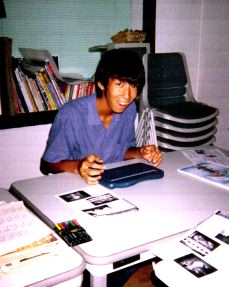
|
|
You can transfer text
data to PC or Mac by simply connect them by a
cable.
|
For human connections, we learned that
asking people for information is still and probably the best
resource specially if we are looking for something local. We
wanted to use some photos of Okaido shopping Arcade in 1940's from
the Internet. We asked for the permission to use them but we were
allowed to use them only a part of that. We were frustrated. And
then, we kept asking if there is anyone who might have the kind of
photos we want. A couple of days later, we found out that one of
our adult students, Mrs.Mitsuru Kamikubota, used to live in the
Arcade before and after the WW2, and she allowed us to use her
family photos for our projects which we can find how people lived
around the area in those days.
|
A lady in
Kimono
|
A man on a
motorbike
|
A meeting at
Bansuiso, the French-sytle building
|

|

|

|
|
ýMitsuru
Kamikubota
|
ýMitsuru
Kamikubota
|
ýMitsuru
Kamikubota
|
- How does your project fit into the
requirements for your school or class?
All the stories about our city, we
translated them as much as we can, and we learned a lot through
the process.
- Has using the Internet for teaching
and learning been more effective than traditional methods?
If so, explain?
We think learning itself hasn't changed
much but its tools has developed a lot. It is important to keep up
with the technology but at the same time we are to cultivate our
own interests, view points, etc. Because we believe using the
Internet is more effective if we can combine it with more field
work.
2) What information tools and
technologies did you use to complete your CyberFair
project?
- Tools we used:
- Alphasmart Keyboards
- Local Area Network
- RichLink Technology by Sentius Co.

- telephones
- TV and radio stations
- video and digital still
cameras
- digitizers and scanners
- tape recorders
- computer software
- libraries
- books, newspapers
- museums
- oral interviews
- Questions to Consider
- How did these tools help
you?
Time saving and could use as
effective tools for students to motivate
- Where did you locate each
tool?
Most of them are at our school,
except the RichLink Technology. We transferred our raw data to
their server computer in California and have them processed.
Want to know more detail? Visit their website here 
- Were any tools donated by
businesses or schools?
No. We would like to keep
asking.
- What were your most valuable
tools? Why?
Alphasmart keyboards. One was one of
the prizes we received from CyberFair 98. It gave our students
a new way for learning English. Since we loved it, we bought
another one for our class use. It is small so that we can carry
them anywhere outside, and it comes with spelling chcker
function. The most appealing poin is that it can hook into
either of PCs or Macintosh and send the text data to your
computer.
3) In what ways did you act as
"ambassadors" and spokespersons for your CyberFair project both
on-line and in person.
We contacted people in various ways. For
the research of the Russian POWs, our students visited a priest whose
grand father used to take care of the Russian Soldier at Chokenji
Temple. For Tobe Pottery, other students visited a potter who donated
his work to the United Nation Office in Geneva for the world peace.
We also were invited to a wonderful dinner party at Dogo Youth Hostel
on our trip. Mr.Sumihiro Kyakuno who retired from the position of
chief Editor of Ehime Newspaper company, allowed us to use magazines
published in 1904 which describes how Russian soldiers lived in
Matsuyama. And we introduced some part of the magazines on our
projects. And through one of the articles from the magazines, we
happened to know Mr. Ken Newcomb who lives in Canada and conducts a
webpage for Newcomb Family. We found out a fact from the magazines
that one of Newcomb Family member was here in Matsuyama visiting
Russian Soldiers from the States in 1904! We emailed him a copy of
the article and some pictures. Now it is introduced on his website as
well.
Last year, we won the second place of the
Cyberfair category of "Local Specialities." And we were introduced on
local TVs and Newspapers. This year, we are on TV before the
competition and not only people of Matsuyama, but Ehime Prefecture
will see our result of the CyberFair 99 Project in May.
|
Nakajima -A
Challenge of My Father -
|
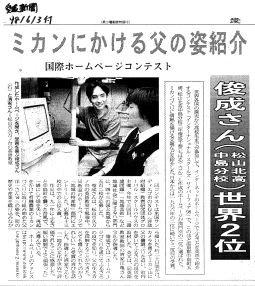
|
|
Ehime Newspaper,
June 3rd, 1998
|
|
|
Local
News
|
|
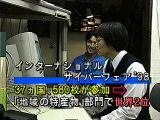
|
|
Ehime TV, June
1998
|
|
Ehime Evening
News
|
|

|
|
NHK, July
1998
|
|
|
Tonikaku
Ehime
|
|
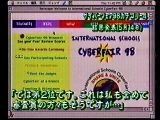
|
|
Ehime TV, June
1998
|
|
|
Time Machine
Matsuyama
|
|

|
|
Ehime Newspaper,
January 3rd, 1999
|
|
|
Nankai Evening
News
|
|

|
|
Nankai News,
February 1999
|
|
Mr. Takeru
Iwamoto, one of our students
|
|
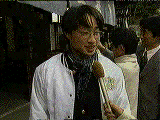
|
|
Nankai News,
February 1999
|
|
|
Magazines
Published in 1904
|
|
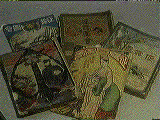
|
|
Nankai News,
February 1999
|
|
Mr. Shouji Hara,
a member of the Association of Okaido Shopping
Arcade
|
|

|
|
Nankai News,
February 1999
|
|
4) What has been the impact of your
project on your community?
- How has your project made a
difference?
Students start to be aware of the relations
between our local history and theirs. And seems that they have
started to build a confidence in themselves that now they can talk
about our home town not only in Japanese but in English as well.
- What is unique about your
presentation within your community?
We presented the idea of being
international to our community. Being international is nothing but
you can talk about yourself and your town and being proud of both of
them.
- Have people in your community
learned new things through your Web pages?
They learned that things we have already
here, nature, temples, town, everything is to be proud of .
Especially, the hospitality we had for the Russian Soldiers, that
is something we must not forget .It was a great opportunity for us
and the community to know that it is possible to do many things
through the Internet, including business, and commerce,
education.
- Have other people around the world
learned new things about your community?
Yes. We contacted Sentius Co.. in
California regarding the RichLink technology. We could use their
automated Documentation Service because they understood the
concept of our school and project for the CyberFair.
- Have you established some new
working relationships with people in the community? Who besides
you and your students has looked at your Web pages?
Yes. Our instructor, Masaki Seike, made
a presentation at Matsuyama JALT meeting, meeting for language
teachers, to talk about the impact of using the Internet in
Educational Field. And many of them checked our site.
- What kind of feedback have you
received?
Not very much for now. But we look
forward to hearing the feedback.
- How has your Web site helped
them?
We don't know now. We will ask them when
we got their messages.
5) How did your project involve other
members of your community as helpers and volunteers?
Our project has been supported
and sponsored by following people and companies:
Our
Sponsors
Mr.Bunji
Matsushita - Founder of
King's English School
He supported us
financially. Thank you, Bunji Sensei!
Mr.Hisashi
Ninomiya - CEO for
VANGUARD Co.,LTD.
He donated us 10
white T-shirts for our students. He used to be our student. And
Helped us in many ways.
Mr. Hara
Shouji and other associates - the Association of Okaido Shopping Arcade
He collected all the
donation from the association members. Students are going to get
about $20 each of Book tickets for further study.
Mrs.Mitsuru
Kamikubota - Student of
KUMANODAI Class
She donated us and
allowed us to use her family photos in our project.
Mr. Youcihi
Toshinari - Father of Chiharu Toshinari who participated in the
CyberFair 98
He
donated us and supported us in many ways.
Ms.Yayomi Miya
Higaki - Student of
KUMANODAI Class
She
donated us and supported us in many ways.
Ms.Mika
Fujiwara - Student of
KUMANODAI Class
She
donated us and supported us in many ways.
Ms. Shiho
Hiraishi - Student of
KUMANODAI Class
She
donated us and supported us in many ways.
Ms.Mihoko
Tamanoi - Mother of Our
Student of KUMANODAI Class
She
donated us and supported us in many ways.
Mr. Hiroshi
Iwamoto - Father of Our
Student, Mr.Takeru Iwamoto
She
donated us and supported us in many ways.
Mr.Toshiaki
Ono - Brother-in-law of
Director Masaki Seike
He
donated us and supported us in many ways.
Our
Helpers and Associates
Mr. Masumi
Abe -
Sentius Co. CA. USA
Helped us to make a contract with them, and provided their wonderful
technology for our project.
Mr.Yasuhiko
Shiraishi - Potter of
Tobe-Yaki in Tobe Town
We interviewed him
and he gave us many references about his work, the blue planet of
life.
Mr. Norio
Yamamoto - President of a company producing insulators in
Tobe.
We
interviewed him and he told us the interesting story of "Hidariuma",
introduced in our project.
Mr. Isao
Hayashi -
the
executive secretary of the Association for Okaido Shopping Arcade 1
chome.
Helped us to meet the people of the Okaido Shopping
Arcade and to have the materials for Okaido Shops.
Mr. Minoru
Oonishi -
the executive secretary of the Association for Okaido Shopping
Arcade3 chome
Helped us to have the materials for Okaido
Shops.
Mr. Seijiro
Mukai -
A coordinator for the Russian and Japanese Children Exchange
Kindly allowed us to use pictures of their activities
and documents.
Matsuyama
Youth Hostel and People
we met there.
Invited our students
for a wonderful dinner and let us rest there after we came back from
our field trip for Dogo area.
Mr.Hideaki
Miyamoto
-Data Control Dept. of Ehime Shinbun Newspaper Co.
Allowed us to use some photo from their
website.
Mr.Sumihiro
Kyakuno - Writer and
Ex-editor of Ehime Shinbun Newspaper Co.
Allowed us to use
magazines published in 1904 about the life of Russian POWs in
Matsuyama.
Mr.Mitsunori
Tsuji - Assistant section
chief of Commerce and Industry Development Dept. of Tobe Town.
Contacted to Myojo
Printing Company for us to get the permission of translating and
publishing the Tobe Comic in English.
Myojo Printing
Co.,LTD.
Holds the copyright
of Tobe Comic and allowed us to use them for our projects.
Ms.Shiho
Tamanoi - Student of
KUMANODAI Class
Ms.Hiroko
Omori - Student of
KUMANODAI Class
These two ladies
helped our students to translate the Tobe Comic into English. Thank
you very much for your support!
To this
page's top
![]()
![]()



